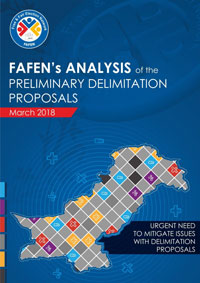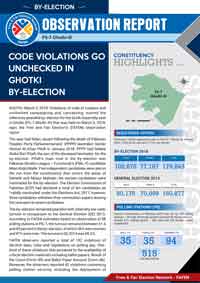- Principle of equality of vote compromised in 81 NA constituencies
ISLAMABAD, March 16, 2018: Free and Fair Election Network (ECP) has identified varying degree of discrepancies in the population size of electoral constituencies in fresh delimitation proposals laid out by the Election Commission of Pakistan (ECP).
While ECP has upheld the legal delimitation principles of geographical compactness and respect for the existing boundaries of administrative units, the principle of equality of vote is compromised in as many as 81 National Assembly constituencies where the variation in population size exceeds the ordinarily permissible legal limit of 10%.
Election Rules, 2017 drafted and approved by ECP appeared to have been strictly adhered to but in that process legal principle of equality of vote is compromised. Rules pertaining to delimitation could not sufficiently operationalize the legal principle of equality of vote among constituencies. Law provides for equality among constituencies but Rules have attempted to follow this principle among provinces and districts.
In a detailed analysis of the Preliminary Report and List of Constituencies released by ECP, FAFEN examined the variations found in the population and voter size of the National Assembly (NA) constituencies with regards to the national, provincial and district averages of population and voters per constituency.
Legally, as far as possible, variation in population of constituencies of an Assembly should not ordinarily exceed ten percent. However, the FAFEN analysis reveals that variation exceeds the limit of ±10% in as many as 81 out of 260 National Assembly constituencies which are being delimited in light of the Elections Act, 2017. The Act allows ECP to deviate from this permissible limit in only exceptional cases; however, the reasons for any such deviation must be recorded in the Delimitation Order. The ECP has used this discretionary power in case of around one-third of the constituencies being delimited which goes against the spirit of the equality of vote as stipulated in the Elections Act 2017.
Of 81 constituencies, 59 constituencies have been suggested with a variations rate between 11% and 20% in 59 constituencies, 11 constituencies have variation between 21% and 30%, six constituencies have a higher degree of variation between 31% and 40% and in cases of five constituencies, this variation is exorbitantly high falling between 41% and 50%.
Each of the three constituencies of Islamabad houses a population 14% less than the national average of population per NA constituency. Similarly, the population in Balochistan NA constituencies is also lower the national average while the population size of constituencies in the remaining three provinces is above the national average.
The variation in population sizes becomes even more obvious within provinces. For instance, NA-37 Tank in Khyber Pakhtunkhwa (KP) represents 391,885 citizens, while a population of around 1.2 million in NA-35 Bannu is suggested to be represented by one National Assembly constituency. The power of vote for Bannu people will be less than a half of one to be enjoyed by people living in Tank constituency. Similarly, in Punjab, NA-37 Jhelum-II has been demarcated as a seat with a population of 546,113 citizens, while NA-87 Hafizabad-I has a population of almost 1.2 million- almost double the Jhelum constituency. In Sindh, NA-199 Shikarpur-II has been created with a population of 588,185 citizens, while NA-197 Kashmore represents a population of 1,089,169 individuals. In Balochistan, NA-262 Kachhi-cum-Jhal Magsi has been allocated a population of just 386,255 citizens against NA-268 Mastung-cum-chaghai-cum-kalat-cum-Shaheed Sikandarabad-cum-Nushki that will represent almost thrice of this population i.e. 1,083,497 citizens. Nationally, the Balochistan constituency NA-262 Kachhi-cum-Jhal Magsi is the smallest with regards to the population size while the KP constituency NA-65 is the largest.
The disparities become more visible when ECP’s voter statistics are applied on the suggested constituencies. If ECP’s voter statistics updated in October 2017 are projected on fresh delimitation proposals, the constituency sizes vary between a voter size of 130,000 to more than 600,000.
FAFEN analysis of potential voting population of suggested constituencies suggests that two NA constituencies – one each in Balochistan and KP – will have less than 150,000 registered voters.
On an average, each NA constituency will potentially have more than 364,000 voters; however, the inter-constituency distribution of voters is skewed. For instance, one Member of National Assembly (MNA) each will represent 130,000 voters for NA-262 and 617,000 voters of NA-19 Haripur. As many as 73 NA constituencies will have less voters than national average of voting population per NA constituency and 85 constituencies will have voters above this average. FAFEN recommended the Election Commission of Pakistan to take the deviation from delimitation principle of capping the variation to ±10% seriously and ensure that the citizen’s right to equal representation is respected everywhere in the country.
As many as 19 constituencies – 10 in Balochistan, and three each in KP, Sindh and ICT – will have a voting population between 150,000 and 249,999 voters. As proposed, more than one third of all NA constituencies, 78 to be precise, will have 250,000 to 349,999 voters. Majority of Sindh constituencies (42 of 61) will have this voting population range. As many as 20 constituencies in Punjab and 13 in KP will also join their Sindh counterparts to have voters in this range. More than half of the overall NA constituencies (138) will have a voting population between 350,000 and 450,000 voters. Overwhelming majority of Punjab constituencies (107 of 141) will fall under this median bracket. As many as 15 NA constituencies will have voters between 450,000 and 550,000 and four constituencies will have more than 550,000 voters.
To download Urdu Press Release, click here | To download the complete report, click here



